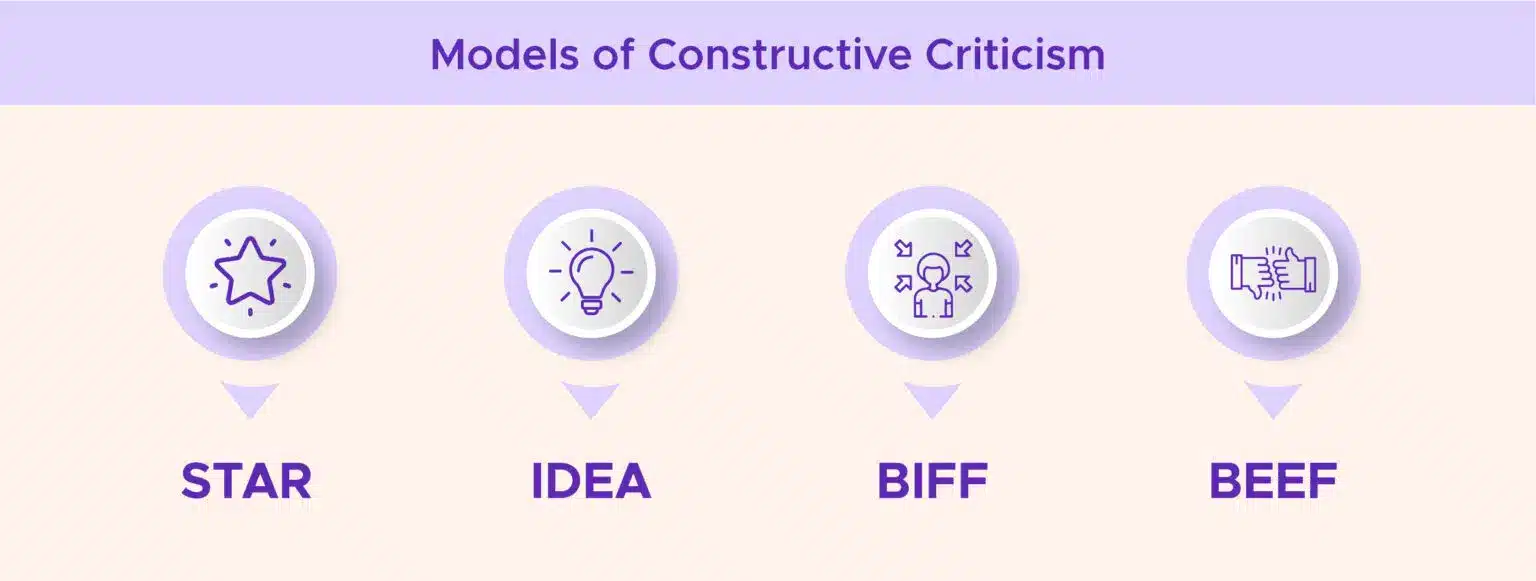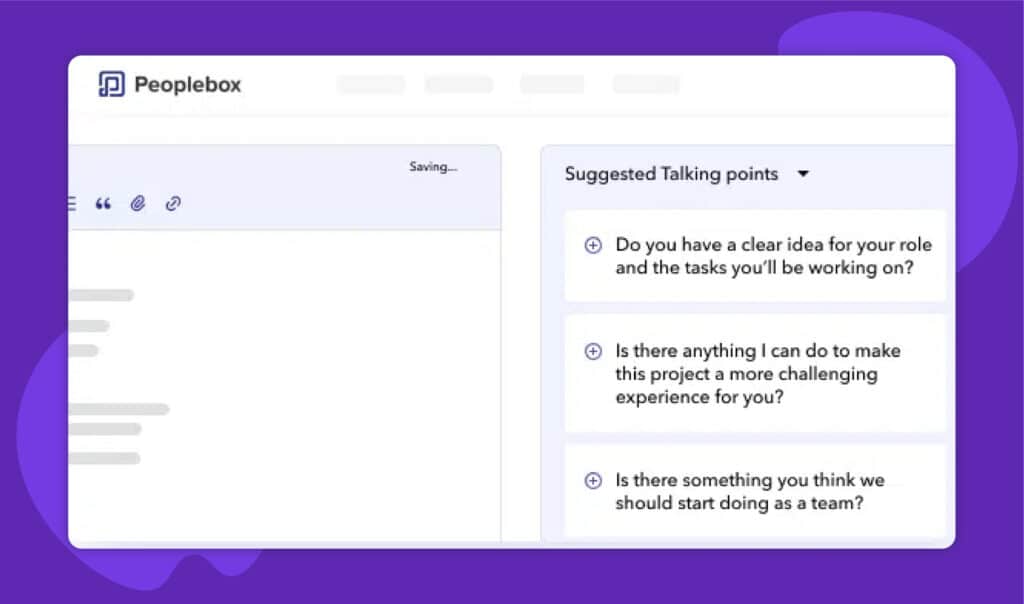Constructive criticism is a powerful tool that can enhance communication and drive growth in any workplace.
By providing specific, actionable feedback, constructive criticism helps individuals and teams identify strengths and areas for improvement, fostering a culture of continuous learning and development.
In this blog post, we will explore what constructive criticism is, why it matters, and how to effectively give and receive it.
Whether you’re a leader aiming to support your team or a colleague looking to enhance collaboration, mastering the art of constructive criticism can lead to improved performance and stronger relationships.
Key Takeaways
✅ Effective constructive criticism pinpoints improvement areas, enhancing skills and fostering a learning culture.
✅ Using models like STAR, IDEA, BIFF, and BEEF ensures feedback is clear, actionable, and respectful.
✅ Approach feedback openly, seek clarity, and collaborate on improvement plans to maximize personal and professional development.

What is Constructive Criticism?
Constructive criticism is helpful feedback that shows how employees can improve their work. It’s given in a positive and respectful way, pointing out both what they’re doing well and what they could do better. The goal is to help them learn and grow, not just to highlight mistakes.
Here are some key characteristics of constructive criticism:
🎯 Specific: It identifies the exact area needing improvement and provides concrete examples.
🎯 Actionable: It offers suggestions or solutions for addressing the issue.
🎯 Positive: It focuses on future improvement rather than dwelling on past mistakes.
🎯 Respectful: It acknowledges the person’s effort and avoids personal attacks.
What is the Purpose of Constructive Criticism?
The purpose of constructive criticism is to provide feedback in a way that helps individuals improve their performance and develop their skills. Here’s how it works:
1. Encourage Growth: Constructive criticism focuses on helping individuals understand their weaknesses and areas for improvement, which can lead to personal and professional growth.
2. Promote Learning: It provides specific, actionable feedback that helps people learn from their mistakes and understand what they can do differently in the future.
3. Build Skills: Constructive criticism helps individuals develop new skills and enhance their abilities by offering clear guidance on how to improve.
4. Enhance Performance: It aims to improve overall job performance by addressing issues and offering solutions, leading to better results and higher efficiency.
5. Foster Communication: Constructive criticism encourages open dialogue and creates opportunities for discussion, which can strengthen relationships and promote a supportive work environment.
6. Boost Motivation: When delivered effectively, constructive criticism can motivate individuals to strive for excellence and take ownership of their development.
In essence, constructive criticism is about helping others succeed by providing feedback that is both helpful and supportive.
What are the Benefits of Constructive Criticism?
Constructive criticism offers several benefits that can enhance personal and professional growth. Here are some of the key advantages:
1. Specific and actionable feedback allows individuals to identify areas of improvement and refine their skills. This leads to a higher quality of work, better decision-making, and ultimately, stronger performance.
2. Constructive criticism fosters a growth mindset, encouraging individuals to view challenges as opportunities to learn and develop. This fosters a culture of continuous improvement and a willingness to embrace new skills.
3. Employees who receive regular, constructive feedback feel valued and invested in. This sense of purpose leads to increased engagement, motivation, and ownership of their work.
4. Feeling valued and supported through constructive criticism can contribute to higher employee satisfaction and lower employee turnover rates. This translates to a more stable and experienced workforce.
5. The practice of giving and receiving constructive criticism hones communication skills. Individuals learn to express themselves clearly and concisely, while also becoming better listeners and more receptive to feedback.
How is Constructive Criticism Different from Destructive Criticism?
Constructive criticism and destructive criticism are two distinct forms of feedback that differ in their intent, tone, and impact on the recipient.
Constructive criticism aims to help individuals improve by providing specific suggestions and solutions, focusing on actions rather than personal attributes. It is delivered in a respectful and considerate manner, with the goal of fostering growth and development.
On the other hand, destructive criticism or negative criticism is negative and harmful, often involving personal attacks, insults, or derogatory language. It is intended to belittle or undermine the recipient, causing emotional and psychological harm.
Here’s a quick comparison of constructive criticism vs destructive criticism:
| Aspect | Constructive Criticism | Destructive Criticism |
| Intent | Aims to help improve and support growth | Aims to belittle and demean |
| Tone | Positive, encouraging, and respectful | Negative, harsh, and disrespectful |
| Focus | Specific issues with actionable suggestions | General or personal attacks without solutions |
| Outcome | Motivates and builds confidence | Demoralizes and reduces self-esteem |
| Language | Uses neutral, objective, and supportive language | Uses subjective, judgmental, and hurtful language |
| Type of Feedback | Balanced with both positive feedback and areas to improve | Solely focuses on negatives |
| Effect on Relationship | Strengthens relationships and fosters trust | Damages relationships and creates distrust |
| Example Phrases | “You did a great job on X, but Y could use some work.” | “You always mess up, can’t you do anything right?” |
What Are Some Models Of Constructive Criticism?
Several models can guide you in delivering effective constructive criticism. Here are a few popular options:

STAR: Situation-Task-Action-Result
👉 Situation: Describe the context or circumstances in which the person’s behavior was observed.
👉 Task: Explain what goal, duty, or responsibility they were given.
👉 Action: Talk about how they responded to that situation and fulfilled their tasks.
👉 Result: Discuss outcomes from those actions as well as their impact on the team, project, or organization’s success/failure rates.
“During the client meeting (Situation), you were tasked with presenting the product’s key features (Task). While your presentation was visually engaging (Action), it lacked specific data points on ROI (Result). Let’s brainstorm ways to incorporate those metrics for future presentations.”
IDEA: Identify-Describe-Encourage-Act
👉 Identify: Specify what exactly needs improving, like area, issue, or behavior.
👉 Describe: Use concrete examples rather than generalizations, and remain objective.
👉 Encourage: Support them by showing confidence in their ability to grow self-awareness and plan for ways to deliver positive reinforcement when they show progress.
👉 Act: Suggest concrete, achievable steps that can help them overcome the identified weakness.
“I’d like to discuss public speaking (Identify). In your recent presentation (Describe), you seemed a bit nervous, which affected your delivery (Describe). Remember, you’re an expert in this field! (Encourage). Let’s practice some breathing exercises to boost your confidence before your next important presentation (Act).”
BIFF: Behavior-Impact-Future-Feelings
👉 Behavior: Only focus on observable acts. Concentrate squarely on tangible things alone.
👉 Impact: Emphasize the consequences and benefits the employee will enjoy from the improved conduct. Mention if the project will benefit or move faster and if their team members will appreciate the changes in the employee.
👉 Future: Propose a solution or alternative approach that the individual can adopt moving forward to achieve better outcomes.
👉 Feelings: Acknowledge and address the employees’s emotional response to the feedback. Criticism, no matter what kind, is never easy to receive, so show empathy and understanding.
“When you interrupt colleagues during meetings (Behavior), it can be hard for them to finish their thoughts (Impact). Moving forward, could we raise hands to speak (Future)? I understand interruptions can be frustrating (Feelings), but this approach will ensure everyone’s voice is heard.”
BEEF: Behavior-Example-Effect-Future
👉 Behavior: Address the employee’s behavior directly and concretely without making any personal comments.
👉 Example: Give the employee examples to provide context and clarity to make it easier for them to understand what you are getting at.
👉 Effect: As with the methods above, the impact of the desired changes on the team, project, and business has to be emphasized to convey how important it is for the employee to work on these changes.
👉 Future: Suggest a course of action and steps that lead to these changes. This also makes it easy to monitor progress as it happens.
“Your reports often miss deadlines (Behavior). For example, last month’s report was delayed by a week (Example). This can cause issues with project timelines (Effect). Let’s explore ways to improve your time management so we can meet deadlines consistently (Future).”
You can always choose to use any model that works best for your organization.

How to Give Constructive Criticism: 5 Best Practices To Follow
1. Be Careful About Timing and Delivery
Select an appropriate time and place for giving constructive criticism. Make sure you do it privately and when they are ready. Don’t catch them at a bad time, or publicize it. Not only will this feedback not be processed if you catch them off guard, but their morale may dip because of this.
Use a tool like Peoplebox to schedule a 1:1 when you want to deliver constructive feedback, so they have a fair idea of what’s coming. Scheduling one-on-ones in peoplebox is simple. Try it yourself!
2. Feedback Should Be Detailed and Actionable
Give recipients specific examples and suggestions on how to improve, a.k.a actionable recommendations. If you want them to improve, you must provide them with a starting point, and you can only do this by not being generic. Concentrate on changeable or learnable behaviors.
Here’s an example:
❌ Generic Feedback: “Your report needs improvement.”
✅ Detailed & Actionable Feedback: “The report’s analysis section lacks data on recent market trends. To improve, add a section with up-to-date market data and include at least three relevant charts to support your findings.”
3. Focus on Behavior, Not the Person
Address actions taken or results achieved without them feeling like personal attacks against their character or identity.
Instead of saying, “You’re always late and unreliable,” try:
“I noticed you’ve missed several deadlines recently. Let’s discuss ways to manage your time better so we can meet deadlines consistently.”
4. Pair the Good With the Bad
Use a variation of the sandwich method. Start on a positive note. Appreciate their strengths and celebrate achievements. Follow that with the hard part about what needs improving and what they can do to overcome obstacles. For example:
Positive: “You’ve been a great team player and your enthusiasm is contagious.”
Area for Improvement: “There were a few instances where communication could have been clearer.”
Action Plan: “Let’s establish regular check-ins to ensure everyone is on the same page.”
5. Make Room for Conversation and Partnerships
Build a safe space and an atmosphere of trust where employees can freely ask questions, share thoughts, have difficult conversations, and engage each other in helpful feedback sessions. Help people listen actively with an open mind to different perspectives.
Okay, now you know how to give constructive feedback. But, what’s the best way to deal with it when you’re on the receiving end?
💡 How to Respond to Constructive Criticism?
Receiving constructive criticism can be daunting, but it is necessary for personal and career growth.
To make feedback a valuable learning experience, you must know how to approach it. Here’s how to get started:
🧘 Take a moment to compose yourself before responding to the feedback. This helps to prevent an emotional response and ensures you can engage with the feedback in a productive manner.
👂 Focus on understanding the feedback rather than immediately responding. This helps to clarify any misunderstandings and ensures you can address the issues effectively.
👐 Approach the feedback with an open mind, recognizing that it is in your best interests and intended to help you improve. This helps to reduce defensiveness and increases the likelihood of a productive conversation.
🙏 Express gratitude to the person providing the feedback. This acknowledges their effort and helps to maintain a positive tone in the conversation.
🤔 Clarify any points you don’t understand and ask questions for additional information to gain a deeper understanding of the feedback. This helps to ensure you can address the issues effectively and make meaningful improvements.
🗒️ Collaborate with the person providing the feedback to build an individual development plan for improvement. This helps to ensure that the feedback is actionable and leads to positive changes.
Now that we’ve discussed the basics, let’s examine some examples of effectively giving and receiving constructive feedback.
🗣️ Examples of Giving Constructive Criticism
Here are some examples of how to deliver constructive feedback effectively:
Example 1: Feedback on a Presentation
“I noticed that your presentation could benefit from more visual aids to help illustrate your points. Perhaps you could include some diagrams or charts to make it more engaging for the audience. Overall, I thought the content was very informative, and your preparation was evident.”
Example 2: Feedback on a Project
“I appreciate the effort you put into this project, but I think it could be improved by focusing on the key objectives and prioritizing the most important tasks. Let’s work together to refine the scope and timeline. I’m confident that with a few adjustments, we can make this project even stronger.”
Example 3: Feedback on Communication
“I’ve noticed that you tend to dominate conversations in meetings. While you have valuable insights, it would be helpful if you let others contribute more. Let’s work on finding a balance so that everyone’s voice is heard next time. I’ve always admired your ability to think critically and share your point of view.”
Example 4: Feedback on Time Management
“I’ve noticed that you’re often running late for meetings. Let’s work on creating a schedule that allows for some buffer time in case of unexpected delays. This will help you feel more in control and reduce stress. I appreciate your dedication and commitment to your work.”
Example 5: Feedback on Teamwork
“I appreciate how you’ve been working with the team to resolve this issue. However, I think we could improve our communication by setting clear goals and roles. Let’s work on defining our objectives and responsibilities. Your collaborative spirit has been a valuable asset to the team.”
For more examples and detailed discussions, read our detailed article on how to give negative feedback effectively.
👂 Examples of Receiving Constructive Criticism
Receiving constructive criticism may be hard, but how you respond to it can greatly affect your professional growth. Here are some examples of how to effectively receive and respond to constructive feedback:
Example 1: Maintaining an Open Mindset
“Thank you for the feedback. I’m open to learning how I can improve.”
Example 2: Asking Clarifying Questions
“Can you give me an example of what you mean by ‘better time management’? I want to make sure I understand the issue.”
Example 3: Acknowledging the Feedback
“I appreciate you taking the time to provide this feedback. It will help me grow professionally.”
Example 4: Developing an Action Plan
“Okay, I understand. Let’s discuss some specific actions I can take to improve this area.”
Example 5: Expressing Gratitude
“Thank you for the feedback. I appreciate your willingness to help me develop my skills.”
🥨 Provide Meaningful Constructive Feedback with Peoplebox
Peoplebox is a comprehensive performance management software that enables organizations to deliver meaningful and actionable feedback.
With Peoplebox, you can manage performance reviews using customizable templates, facilitate continuous feedback through features like 1:1 meetings and scheduled check-ins, and guide constructive conversations with talking points and prompts.

The platform ensures fair and objective evaluations with real-time calibration functionalities and advanced analytics, and provides white-glove support to ensure a smooth transition and optimal usage.
By promoting a culture of feedback, Peoplebox helps drive employee engagement, growth, and ultimately, better business success.
Ready to build a thriving workforce? Book a demo now.








